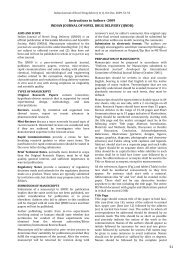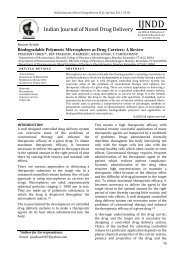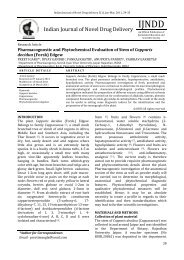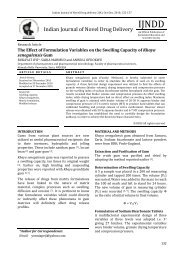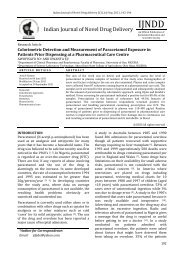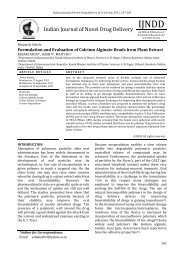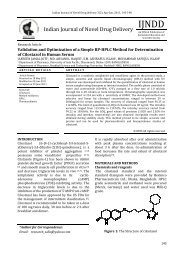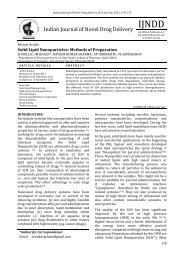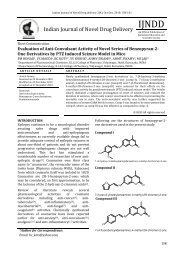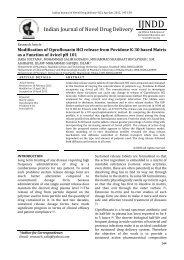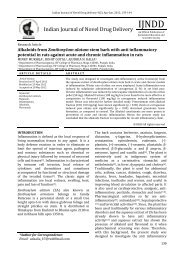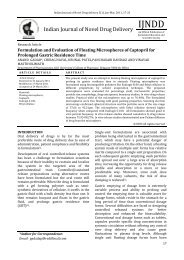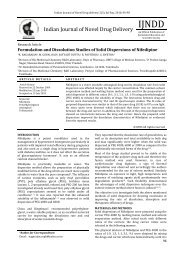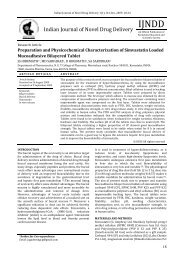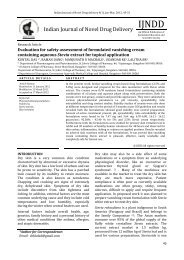Mucoadhesive Polymers - Indian Journal of Novel Drug Delivery
Mucoadhesive Polymers - Indian Journal of Novel Drug Delivery
Mucoadhesive Polymers - Indian Journal of Novel Drug Delivery
Create successful ePaper yourself
Turn your PDF publications into a flip-book with our unique Google optimized e-Paper software.
Swamy NGN et al / <strong>Indian</strong> <strong>Journal</strong> <strong>of</strong> <strong>Novel</strong> <strong>Drug</strong> <strong>Delivery</strong> 4(1), Jan-Mar, 2012, 2-16<br />
been clearly demonstrated for polycarbophil and<br />
more recently for chitosan [42] . This has also been<br />
exploited in development <strong>of</strong> pH-sensitive<br />
mucoadhesive polymers.<br />
Physiological-related factors<br />
Mucociliary clearance, mucus turnover and<br />
diseased states are physiological factors which<br />
influence nasal mucoadhesion. Mucoadhesion<br />
can slow down mucociliary clearance, but with<br />
time, mucus production reduces the<br />
mucoadhesion bond strength, allowing a<br />
recovery <strong>of</strong> mucociliary clearance to normal<br />
clearance rates, thereby removing the<br />
mucoadhesive. Diseased conditions mentioned<br />
earlier can affect mucoadhesion due to their<br />
influence on either mucus production or ciliary<br />
beating. Thus a good understanding <strong>of</strong> the nature<br />
<strong>of</strong> mucus in these diseases is imperative in<br />
designing a good nasal drug delivery system. An<br />
abnormal mucus layer could present an<br />
unanticipated barrier to drug transport through<br />
the mucosa. <strong>Mucoadhesive</strong> capabilities <strong>of</strong><br />
polymers should be studied during product<br />
development under such diseased conditions as<br />
considered relevant.<br />
<strong>Mucoadhesive</strong> polymers used in nasal drug<br />
delivery<br />
Cellulose derivatives<br />
Cellulose is a class <strong>of</strong> most available<br />
polysaccharide, consisting <strong>of</strong> 8000–10,000<br />
glucose residues linked by β-1,4glucosidic bonds.<br />
There are many pharmaceutical grade<br />
derivatives <strong>of</strong> cellulose widely used in different<br />
administration routes. Several cellulose<br />
derivatives have proved to be effective in<br />
enhancing the intranasal absorption <strong>of</strong> drugs,<br />
including soluble cellulose derivatives such as<br />
hydroxypropyl methylcellulose (HPMC),<br />
hydroxypropyl cellulose (HPC), methylcellulose<br />
(MC) and carboxymethyl cellulose (CMC), and<br />
insoluble cellulose derivatives such as<br />
ethylcellulose (EC) and microcrystalline cellulose<br />
(MCC). Table 2 summarizes the nasal drug<br />
delivery studies where the cellulose derivatives<br />
were employed as mucoadhesive carrier.<br />
Cellulose derivatives can markedly prolong the<br />
residence time <strong>of</strong> drugs in the nasal cavity<br />
because <strong>of</strong> their desirable mucoadhesive<br />
property [43] . Additionally, because <strong>of</strong> their high<br />
viscosity following hydration in the nasal cavity,<br />
the celluloses can sustain the release <strong>of</strong> drugs [44] .<br />
For these reasons using celluloses as absorption<br />
enhancers can lead to improved intranasal<br />
absorption and increased bioavailability. Many<br />
references show that the celluloses are effective<br />
in increasing the intranasal bioavailability <strong>of</strong><br />
small hydrophobic and hydrophilic<br />
macromolecular drugs (Table 2). For example,<br />
Apomorphine administered nasally with CMC,<br />
can obtain a relative bioavailability <strong>of</strong> 102%<br />
compared with subcutaneous injection in<br />
rabbits. Another study reported that an absolute<br />
bioavailability up to 90.77% could be achieved<br />
for ketorolac tromethamine administered with<br />
MCC [45] . The peptide drugs leuprolide and FD-4,<br />
when dosed with MCC/HPC through nasal route,<br />
reached an absolute bioavailability <strong>of</strong> 34.9% and<br />
35.5% in rabbits, respectively [46] .<br />
Sometimes, combination <strong>of</strong> the celluloses with<br />
other absorption enhancer would obtain better<br />
effectiveness than using the polymer alone.<br />
Ozsoy et al. have reported that the intranasal<br />
absolute bioavailability <strong>of</strong> cipr<strong>of</strong>loxacin in<br />
rabbits using MC and hydroxyethyl cellulose<br />
(HEC) alone as enhancer is only 18.2% and<br />
19.46%, respectively. When combined with<br />
Tween 80, the bioavailability increased to<br />
22.35% and 25.39%, respectively [47] . In another<br />
study by Ikeda et al. involving the intranasal<br />
delivery <strong>of</strong> dopamine, the combination <strong>of</strong> the<br />
HPC and azone led to an absolute bioavailability<br />
<strong>of</strong> almost 100% whereas it was only 25% with<br />
HPC alone [48] .<br />
Polyacrylates<br />
Polyacrylates have been investigated very<br />
frequently in many drug administration routes,<br />
such as oral [49] , ocular [50] , transdermal [51, 52] and<br />
nasal [53] drug delivery systems, because <strong>of</strong> their<br />
excellent mucoadhesive and gel-forming<br />
capability. Among the pharmaceutical<br />
polyacrylates, carbomers and polycarbophil,<br />
which differ in the cross-linking condition and<br />
viscosity, are widely used in the nasal<br />
mucoadhesive drug delivery systems [54] . Table 3<br />
summarizes the studies on the use <strong>of</strong><br />
polyacrylates in nasal drug delivery system.<br />
Polyacrylates, capable <strong>of</strong> attaching to mucosal<br />
surfaces, can <strong>of</strong>fer the prospects <strong>of</strong> prolonging<br />
the residence time <strong>of</strong> drugs at the sites <strong>of</strong> drug<br />
absorption and ensure intimate contact between<br />
the formulation and the membrane surface.<br />
Studies by Ugwoke et al. in rabbits have reported<br />
that the use <strong>of</strong> Carbopol 971P in nasal dosage<br />
forms increased the residence time in the nasal<br />
cavity. The percentage <strong>of</strong> the formulations<br />
cleared from the nasal cavity at 3 hours was 24%<br />
for Carbopol 971P, whereas it was 70% for<br />
7



